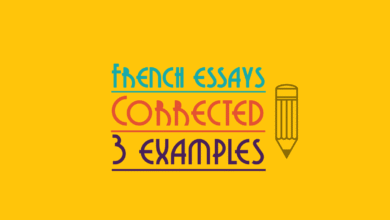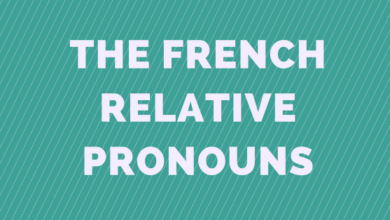
The verb VOIR usually means to see (although it can also mean to understand) and has irregular forms in just about every tense and mood. It is also classified as a verb of perception which means it uses sight, sound or touch to perceive something, and that thing can be an action or an object.
In this article, you’re going to learn about some of the more common uses of VOIR and the VOIR conjugation in French. A short quiz at the end will help you remember some of the key parts and uses of the verb.

Uses of VOIR
VOIR is another irregular verb, meaning it doesn’t follow a recognised pattern when you conjugate it. Make sure you look out for the many irregularities in the different tenses and moods but see if you can start to see similarities in the structure of different tenses.
VOIR is used in three different ways.
-
1
In its simplest sense, it means ‘to see’ or ‘to experience’. Example: Je vois les poissons dans la mer (I see the fish in the see) and Il a vu la mort de son chien (He saw the death of his dog).
-
2
VOIR can also mean ‘to see’ in the sense of ‘to understand’ Example: Ah oui, je vois (Oh yes, I understand).
-
3
And it is found in a number of idiomatic expressions. Example: Je te vois venir (I see where you’re going (with that)).
Click on this link to see some of the more common uses of VOIR.
Conjugation of VOIR
As you now know, this is an irregular verb and doesn’t follow any of the regular patterns so learning it could be a chore. Keep repeating the verb and listening to the audio, though, and you’ll learn it in no time, but remember that often, different spellings can sound the same in French, so it’s important you secure the spellings as well as the sounds of the words.
Let’s review the VOIR conjugation in the indicative mood.

How to conjugate VOIR in the present tense (Présent)
In English, there are two present tenses – the Present Simple and the Present Continuous. In French, there’s only one tense – Le Présent. French is easy, right?
In the present tense table below, you can see the two different VOIR conjugations and their meanings in English.
| Je vois | I see, I am seeing |
| Tu vois | You see, you are seeing |
| Il / elle voit | He / she sees, he / she is seeing |
| Nous voyons | We see, we are seeing |
| Vous voyez | You see, you are seeing |
| Ils / elles voient | They see, they are seeing |
How to conjugate VOIR in the Imparfait
The imperfect is used to create a sense of something that continued happening in the past. In English we would say ‘I was doing something’ or that ‘I used to do it’.
| Je voyais | I was seeing |
| Tu voyais | You were seeing |
| Il / elle voyait | He / she was seeing |
| Nous voyions | We were seeing |
| Vous voyiez | You were seeing |
| Ils / elles voyaient | They were seeing |
How to conjugate VOIR in the Futur
| Je verrai | I will see |
| Tu verras | You will see |
| Il / elle verra | He / she will see |
| Nous verrons | We will see |
| Vous verrez | You will see |
| Ils / elles verront | They will see |
How to conjugate VOIR in the Passé Composé
| J’ai vu | I saw |
| Tu as vu | You saw |
| Il / elle a vu | He / she saw |
| Nous avons vu | We saw |
| Vous avez vu | You saw |
| Ils / elles ont vu | They saw |
How to conjugate VOIR in the Passé Simple
| Je vis | I saw |
| Tu vis | You saw |
| Il / elle vit | He / she saw |
| Nous vîmes | We saw |
| Vous vîtes | You saw |
| Ils / elles virent | They saw |
How to conjugate VOIR in the Plus-que-Parfait
| J’avais vu | I had seen |
| Tu avais vu | You had seen |
| Il / elle avait vu | He / she had seen |
| Nous avions vu | We had seen |
| Vous aviez vu | You had seen |
| Ils / elles avaient vu | They had seen |
How to conjugate VOIR in the Passé Antérieur
| J’eus vu | I had seen |
| Tu eus vu | You had seen |
| Il / elle eut vu | He / she had seen |
| Nous eûmes vu | We had seen |
| Vous eûtes vu | You had seen |
| Ils / elles eurent vu | They had seen |
How to conjugate VOIR in the Futur Antérieur
| J’aurai vu | I will have seen |
| Tu auras vu | You will have seen |
| Il / elle aura vu | He / she will have seen |
| Nous aurons vu | We will have seen |
| Vous aurez vu | You will have seen |
| Ils auront vu | They will have seen |
How to conjugate VOIR in the Subjunctive mood (Subjonctif)
How to conjugate VOIR in Present Subjunctive (Subjonctif Présent)
| que je voie | that I see |
| que tu voies | that you see |
| qu’il / elle voie | that he / she sees |
| que nous voyions | that we see |
| que vous voyiez | that you see |
| qu’ils / elles voient | that they see |
How to conjugate VOIR in Imperfect Subjunctive (Subjonctif Imparfait)
| que je visse | that I was seeing |
| que tu visses | that you were seeing |
| qu’il / elle vît | that he / she was seeing |
| que nous vissions | that we were seeing |
| que vous vissiez | that you were seeing |
| qu’ils / elles vissent | that they were seeing |
How to conjugate VOIR in Past Subjunctive (Subjonctif Passé)
| que j’aie vu | that I saw |
| que tu aies vu | that you saw |
| qu’il / elle ait vu | that he / she saw |
| que nous ayons vu | that we saw |
| que vous ayez vu | that you saw |
| qu’ils / elles aient vu | that they saw |
How to conjugate VOIR in Past Perfect Subjunctive (Plus-que-Parfait)
| que j’eusse vu | that I had seen |
| que tu eusses vu | that you had seen |
| qu’il / elle eût vu | that he / she had seen |
| que nous eussions vu | that we had seen |
| que vous eussiez vu | that you had seen |
| qu’ils / elles eussent vu | that they had seen |
How to conjugate VOIR in the Conditional Mood (Conditionnel)
How to conjugate VOIR in the Present Conditional (Conditionnel Présent)
| Je verrais | I would see |
| Tu verrais | You would see |
| Il / elle verrait | He / she would see |
| Nous verrions | We would see |
| Vous verriez | You would see |
| Ils / elles verraient | They would see |
How to conjugate VOIR in the Past Conditional (Conditionnel Passé)
| J’aurais vu | I would have seen |
| Tu aurais vu | You would have seen |
| Il / elle aurait vu | He / she would have seen |
| Nous aurions vu | We would have seen |
| Vous auriez vu | You would have seen |
| Ils / elles auraient vu | They would have seen |
How to conjugate VOIR in Participe
| Présent | voyant |
| Passé | vu |
| Passé Composé | ayant vu |
How to conjugate VOIR in the Imperative Mood (Impératif)
| Présent | (tu) voie (nous) voyons (vous) voyez |
| Passé | (tu) aie vu (nous) ayons vu (vous) ayez vu |
How to conjugate VOIR in the Infinitive Mood (Infinitif)
| Présent | voir |
| Passé | avoir vu |
Quick Exercise – fill in the blanks
1. Il _____ ses parents le samedi.
ANSWER: Il voit ses parents le samedi.
2. Tu ________ le médecin demain?
ANSWER: Tu verras le médecin demain?
3. J’ai ____ les enfants jouer dans le parc.
ANSWER: J’ai vu les enfants jouer dans le parc.
4. Il faut que je ______ le dentiste bientôt.
ANSWER: Il faut que je voie le dentiste bientôt.
5. _____ s’il y a du pain dans le placard.
ANSWER: Voie / Voyez s’il y a du pain dans le placard.
6. Je n’ai rien eu a ______ avec le vol.
ANSWER: Je n’ai rien eu a voir avec le vol.
7. Hier, nous avons ___ un groupe fantastique.
ANSWER: Hier, nous avons vu un groupe fantastique.
8. Je _______ mes grand-parents chaque week-end quand j’étais petit.
ANSWER: Je voyais mes grand-parents chaque week-end quand j’étais petit.
9. Vous ______ votre patron au bureau demain?
ANSWER: Vous verrez votre patron au bureau demain?
10. Je n’ai rien à ______ avec cela.
ANSWER: Je n’ai rien à voir avec cela.
Conclusion
VOIR is another useful but irregular verb to learn. It has its peculiarities in the VOIR conjugation, but you can learn it easily. You might by now be starting to recognise the different patterns that the different tenses bring, and that usually only parts of each form will actually change. Understand the pattern and then think about how the verb you’re learning modifies what you know.
So how will you go about learning them? If you thought learning verbs meant learning by rote and chanting your way through them, you’re mistaken. You can easily and naturally get them set in your memory if you use the audio drills every day.




